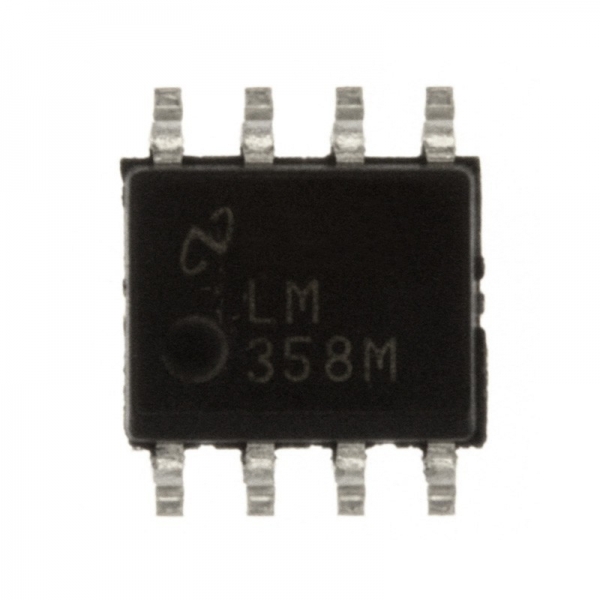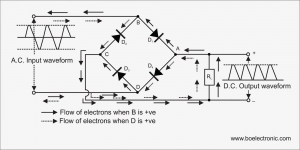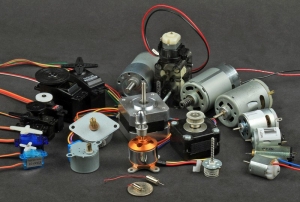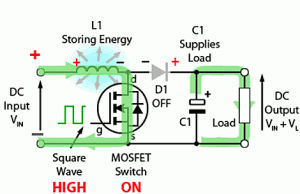
This page provides basic information about voltage comparator integrated circuits and is to act as reference material for other circuits. The circuits shown are based on the LM339 Quad Voltage Comparator chip or the LM393 Dual Voltage Comparator chip. These devices are functionally the same. The LM311 Voltage Comparator can be used for these applications as well but it also has a number of unique features.
Voltage Comparator - Open Collector Outputs
The outputs of voltage comparators are open collector outputs.
Open collector type outputs can only sink current. This means that there is no true output from a collector but a rather a current or voltage must be supplied to the output terminal from a source elsewhere in the larger circuit.
In some circuits a pull-up resistor is used at the output of a comparator to provide an output voltage signal to the input of another device.
NOTE: Operational Amplifiers (OPAMPS) such as LM324, LM358 and LM741 are not normally used voltage comparator circuits due to their bipolar outputs. However, OPAMPS can be used as voltage comparators if a diode or transistor is added to the amplifiers output to create and open collector type output. A diagram showing this addition is further down this page.
Inputs Vs. Output Rules
- Current WILL flow through the open collector when the voltage at the PLUS input is lower than the voltage at the MINUS input.
- Current WILL NOT flow through the open collector when the voltage at the PLUS input is higher than the voltage at the MINUS input.
Pin Diagram For An LM339
Print the diagram in the centre of a sheet of paper and then draw a circuit using the ICs pin locations.
Pin Diagram For An LM393
Print the diagram in the centre of a sheet of paper and then draw a circuit using the ICs pin locations.
Pin Diagram For An LM311
Print the diagram in the centre of a sheet of paper and then draw a circuit using the ICs pin locations.
Comparator Equivalent Circuits
For Single Power Supplies
An integrated circuit "Voltage Comparator" is equivalent to an Operational Amplifier, Such as the LM358 or LM324, with two NPN transistors added to the output of each amplifier. (Refer to the above schematic.) This arrangement produces an "Open Collector" output for each of the four comparators in an LM339 chip. Each output can sink 15 Milliamps and can withstand voltages of up to 50 Volts.
The output is switched ON or OFF depending on the relative voltages at the PLUS and MINUS inputs of the comparator, see the rules below. The inputs are quite sensitive and a difference of only a few millivolts between them will cause the output to turn on or off.
The LM339, LM393 and LM311 comparator chips can operate from a single or dual power supply of up to 32 volts maximum.
When operated from Dual or Split power supplies the basic operation of comparator chips is unchanged except that for most devices the emitter of the output transistor is connected to the negative supply rail and not the circuit common. An exception to this is the LM311 which has a separate emitter terminal that can be connected to either the minus or neutral of the supply.
Dual Supply Comparator Equivalent schematic
When operated from Dual or Split power supplies the input voltages can be above or below the common or zero voltage of the supply. Also, one of the comparator's inputs can be connected to the common so that a 'Zero Crossing' detector is created.
Comparator Operation
The following drawing show the two simplest configurations for voltage comparators. The diagrams below the circuits give the output results in a graphical form.
For these circuits the REFERENCE voltage is fixed at one-half of the supply voltage while the INPUT voltage is variable from zero to the supply voltage.
In theory the REFERENCE and INPUT voltages can be anywhere between zero and the supply voltage but there are practical limitations on the actual range depending on the particular device used.
Input Vs. Output Results
-
Current WILL flow through the open collector when the voltage at the PLUS input is lower than the voltage at the MINUS input.
-
Current WILL NOT flow through the open collector when the voltage at the PLUS input is higher than the voltage at the MINUS input.
Input Offset Voltage
Voltage comparators are not perfect devices and their performance may suffer from the effects of a parameter known as the Input Offset Voltage. The Input Offset Voltage for many comparators is only a few millivolts and in most circuits can be ignored.
Problems related to the Input voltage normally occur when the Input voltage changes very slowly.
The net result of the Input Offset Voltage is that the output transistor does not fully turn on or off when the input voltage is close to the reference voltage.
The following diagram attempts to illustrate the effect of the input offset voltage with a slowly changing input voltage. This effect increases as the output transistor current increases so keeping the value of RL high will help reduce the problem.
The effects of the input offset voltage can be countered by adding hysteresis to the circuit. This causes the reference voltage to change when the comparators output goes high or low.
Input Offset Voltage And Hysteresis
For most comparator circuits Hysteresis is the difference between the input signal voltages at which a comparator's output is either fully ON or fully OFF. Hysteresis in comparators is generally undesirable but it can also be added to a circuit to reduce the sensitivity to noise or a slowly moving input signal.
Internal hysteresis that is normal for comparators causes the output of the comparator to go from OFF to ON and vice-versa relatively slowly.
External hysteresis uses positive feedback from the output to the non-inverting input of the comparator. The resulting Schmitt trigger type circuit gives additional noise immunity and a cleaner output signal.
The effect of added hysteresis is that as the input voltage slowly changes, the reference voltage will quickly change in the opposite direction. This gives the comparator's output a "snap" action.
A mechanical analog of added hysteresis can be found in many toggle switches: As the handle moves past its center point, a spring in the switch forces the contacts of the switch to open or close, ensuring that the switch's contacts snap to the ON or OFF position.
The width of the loop outlined by an OFF-ON-OFF cycle is the input hysteresis voltage.
The inherent hysteresis voltage for most comparators is only a few millivolts and usually only affects circuits where the input voltage rises or falls very slowly or has voltage spikes known as "noise".
Adding Hysteresis To A Comparator Circuit
A comparator's Hysteresis range can be increased by adding a resistor between the comparator's output and the PLUS input terminal. This creates a feedback loop so that when the output makes a transition the feedback changes the voltage at the positive which increases the voltage difference between the PLUS and MINUS inputs.
The feedback can only be made to the PLUS input terminal.
Increasing The Input's Hysteresis Range
If the comparator's output is initially 'OFF', the MINUS input voltage has to become above the PLUS input voltage by the hysteresis voltage range before the comparator output turns 'ON'.
If the comparator is 'ON', the MINUS input voltage needs to drop slightly below the PLUS input voltage by the hysteresis voltage range before it turns 'OFF'.
The hysteresis voltage range can be made large in order to force the comparator's output to change as quickly as possible. The FLIP-FLOP circuits shown later on this page make use of a large hysteresis to create the memory effect with large input voltage changes needed to trigger a change in the output.
Hysteresis Resistor Calculator Page At AKAWA Electric Design
Other Hysterysis Schemes
Adding Separating Diodes To A Comparator's Output
A diode can be added to the output of a comparator to allow a LED to indicate if the output of the comparator is HIGH or LOW without affecting the circuit that the comparator is connected to.
Diodes can also be used to separate multiple circuits connected to a single comparator.
Output Diodes
Voltage Window Detector Circuit
Comparators with Open Collector outputs such as the LM339 or LM393 must be configured so the both outputs are HIGH when the voltage is within the desired limits. The LM311 comparator can have other output arrangements as it has both an open collector and open emitter on the output transistor.
Window Comparator
Comparator Oscillator Circuit
Comparators can also be used as oscillators but are not well suited for this type of application.
Oscillator Made From A Comparator
Basic Comparator Circuits
The following diagrams are of some basic comparator circuits. Most have a Cadmium Sulfide photocell input but could just as easily use a phototransistor or a voltage signal from another circuit as an input. The resistance values are not critical but should be used as a guide. In most comparator circuits the ratio of the resistances is more important than their actual values.
Photocell Circuits
Photocell Circuits Schematic
If higher current loads are to be driven a PNP transistor can be added to the comparators output this will allow loads of up to 300Ma. to be controlled.
Relay Driver Output Schematic
Time Delay Circuits
Short timing functions such as a pulsed outputs or time delays can also be created with one or two comparator sections.
Comparator Time Delay Schematic 1
Notice that the second comparator section in the time delay circuit shares the same reference voltage input as the first. In most cases any number of comparators can have the same voltage source at one input, this can make circuits much less complicated.
More Delay circuits.
Comparator Timer Delay Schematic 2
Comparator Timer Delay Schematic 3
Comparator Power-On Delay Circuit
Basic Memory Functions
Comparators can be made to perform a basic memory function by wiring them as a 'SET / RESET' type of FLIP/FLOP. This type of circuit can be used in unplugable walk around throttles to remember the direction of the train when the controller is disconnected. In the next diagram the comparator will remember which switch was pushed last. If the 'SET' button is pushed the LED will be on, the 'RESET' button will turn the LED off. A higher current version is also shown.
Comparator FLIP/FLOP Schematic
How the Flip Flop works. A very basic description.
-
When the output of the comparator is off the voltage at the PLUS input will be the same as the supply voltage. With the PLUS input voltage higher than the MINUS input voltage the output will remain off.
-
When the SET button is pushed the voltage at the PLUS input will go to zero and the output will turn on.
-
When the SET button is release the voltage at the PLUS input will rise to 1/2 of the supply voltage and the output will remain turned on because the voltage at the PLUS input is remains below the voltage at the MINUS input.
-
When the RESET button is pressed voltage at the MINUS input will go to zero from its normal level of 3/4 of the supply voltage. The output will turn off because the voltage at the MINUS input is below the voltage at the PLUS input. When the output turns off the voltage at the PLUS input will rise to the supply voltage level.
-
When the RESET button is released the voltage at the MINUS input will rise to 3/4 of the supply voltage. The PLUS input voltage will stay above the voltage at the MINUS input and the output will stay turned off.
Open Collector Output Transistors
Because the output transistor of the comparator has an open collector the supply and load voltages do not have to be the same. This means that the comparator could use a 12 Volt power supply while the load could be a 24 Volt relay or 5 Volt LED circuit.
The following three diagrams are some examples of Dual voltage circuits. In the first two the voltage at the output of the comparators could even be full wave direct current.
Dual Voltage Output Schematic
Dual Voltage Relay Driver Output Schematic
Dual Voltage FLIP/FLOP Schematic
4 Level - Voltage Detector
This circuit can sequentially indicate 4 voltage levels. The voltages that the LEDs turn on at are determined by the values of resistors R1 through R5 arranged in a simple voltage divider circuit.
4 Level Detector Schematic
This circuit lacks a stable reference voltage and is therefore not suitable for indicating the voltages of batteries as the reference voltages will decrease as the the battery voltage decreases.
An IC that is designed for voltage level indication is the LM3914 - Dot/Bar Display Driver. The LM3914 is a monolithic integrated circuit that senses analog voltage levels and drives 10 LEDs, providing a linear analog display.
There is also the LM3915 - Dot/Bar Display Driver. The LM3915 is a monolithic integrated circuit that senses analog voltage levels and drives ten LEDs, LCDs or vacuum fluorescent displays.
4 Level - Bidirectional Delay
This circuit turns the LEDs on or off in roughly equal steps in both directions. For example ON - 1 - 2 - 3 - 4 and then OFF - 4 - 3 - 2 - 1.
Bidirection Delay Schematic
This resistor network at S1 brings the reference voltage closer to the threshold voltages to minimize the charging/discharging delay in C1 when S1 is swung.
Exclusive OR circuit
In this circuit only one LED can be on at a time.
Exclusive OR Schematic
Using An OPAMP As A Comparator
Operational Amplifiers can be used as comparators by adding a diode or transistor to the OPAMP's output. Using a transistor allows for a greater output current capacity than that of a typical comparator.
Comparator Made From An Operational Amplifier
Some Other Circuits
LM311 Comparator Used To Control An 'H-Bridge Circuit
Light Activated Relay With 5 Second Release Delay
Voltage Comparator Page On Wikipedia
Comparator Hysteresis Network Calculator Page
Return to the Main Page
Please Read Before Using These Circuit Ideas
The explanations for the circuits on these pages cannot hope to cover every situation on every layout. For this reason be prepared to do some experimenting to get the results you want. This is especially true of circuits such as the "Across Track Infrared Detection" circuits and any other circuit that relies on other than direct electronic inputs, such as switches.
If you use any of these circuit ideas, ask your parts supplier for a copy of the manufacturers data sheets for any components that you have not used before. These sheets contain a wealth of data and circuit design information that no electronic or print article could approach and will save time and perhaps damage to the components themselves. These data sheets can often be found on the web site of the device manufacturers.
Although the circuits are functional the pages are not meant to be full descriptions of each circuit but rather as guides for adapting them for use by others. If you have any questions or comments please send them to the email address on the Circuit Index page.





